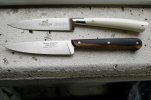Nice to see activity in this thread again. Here are two German-made knives from around the same period (most likely pre-WW2) and in a similar style, despite the different formats (with chromed blades and turned horn handles), both most likely made for the Brazilian market:
The clip-point
verijero I had already shown, with its new sheath fittings, though here it is after I took care of the handle (the bolster ferrule had a rotten-away section, so I made a new one, and the horn handle was effectively split, so I glued it back together, filled the cracks, and relacquered it). The other one is a relatively small hunting
facón marked "D.R.G.M." (standing for
Deutsches Reichsgebrauchsmuster), featuring what I assume to be the Greek goddess Diana's face on the ricasso with traces of a gold wash.
Edit: I originally told
 screened porch
screened porch
that I didn't think the blade of the
verijero was plated, but upon further inspection and comparison with other knives, now I believe it's chrome-plated.


























